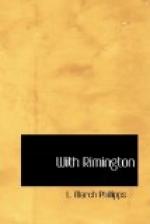We crossed the Vaal at Lindiquies Drift, being now on the west flank, and met the Boers the day before yesterday two miles from here on the West Rand. The fight was a sharp one. They were in a strong position on some ridges, not steep, but with good cover among stones and rocks. We came at them from the west, having made a circuit. Our advance was hidden by the rolling of the ground, but the enemy guessed it, and sent a few shells at a venture, which came screaming along and buried themselves in the ground without doing much damage that I could see beyond knocking a Cape cart to pieces. By 2 P.M. we had crawled up the valley side and got several batteries of artillery where they could shell the Boer position. The two great “cow-guns,” so called from the long teams of oxen that drag them, were hauled up the slope. The enemy got an inkling of our intention now, and his shells began to fall more adjacent. Then our fire began. It was difficult to see clearly. The dry grass of the veldt, which is always catching fire, was burning between us and the Boers; long lines of low smouldering fire, eating their way slowly along, and sending volumes of smoke drifting downward, obscuring the view. Half the ground was all black and charred where the fire had been; the rest white, dry grass. The Boer position was only about two miles from our ridge; a long shallow hollow of bare ground, without bush or rock, or any sort of cover on it, except a few anthills, separating us from them. Our field-batteries opened, and then the great five-inch cow-guns roared out. We ourselves were close to these with Hamilton (we are acting as his bodyguard), and with the other officers I crept up to the ridge and lay among the




